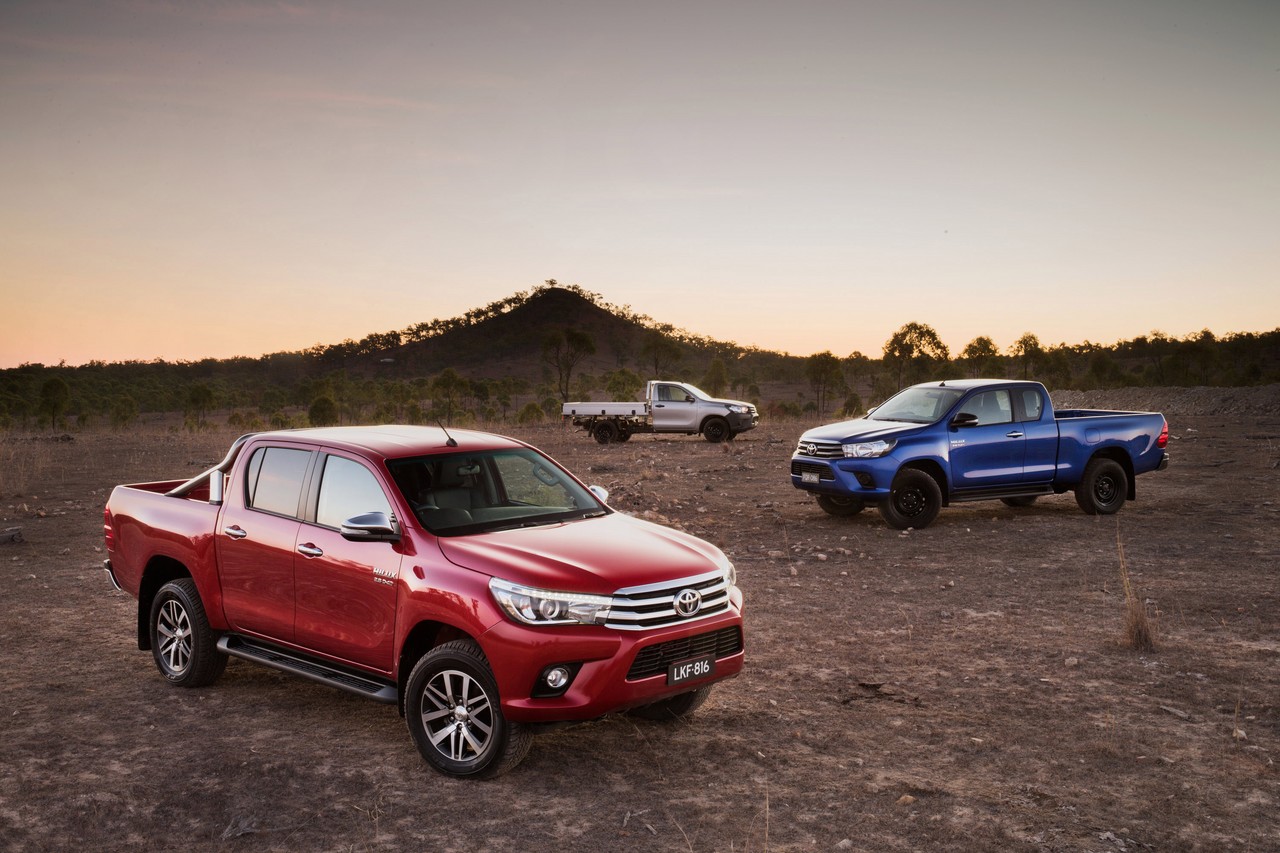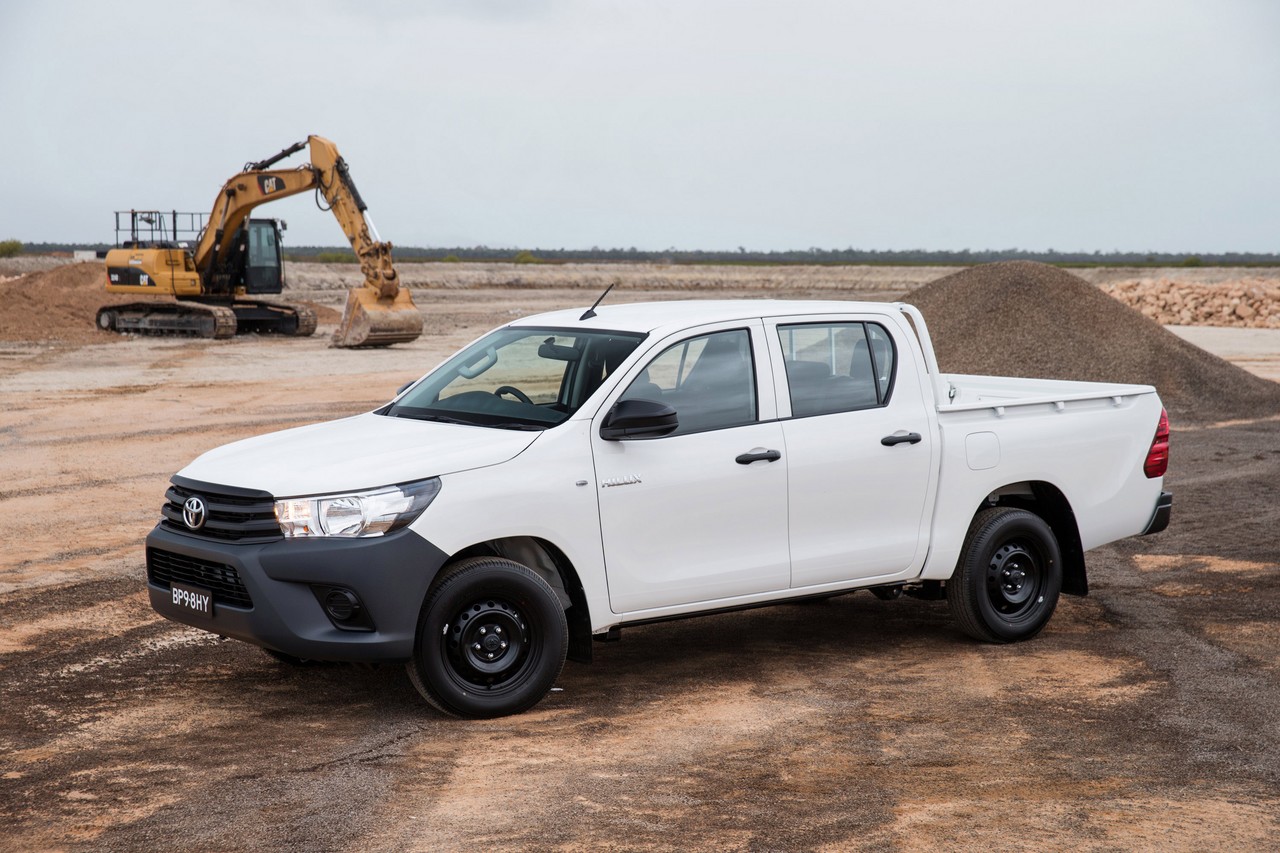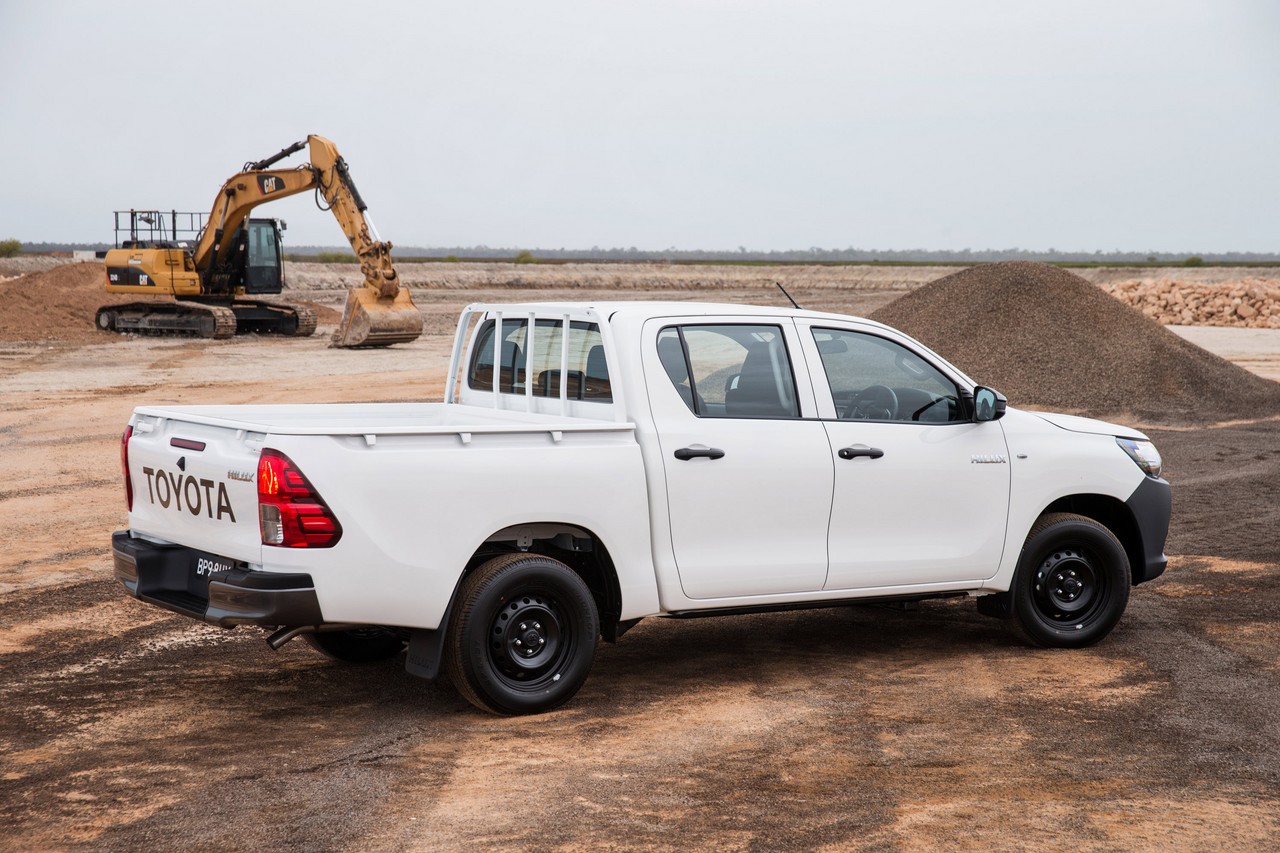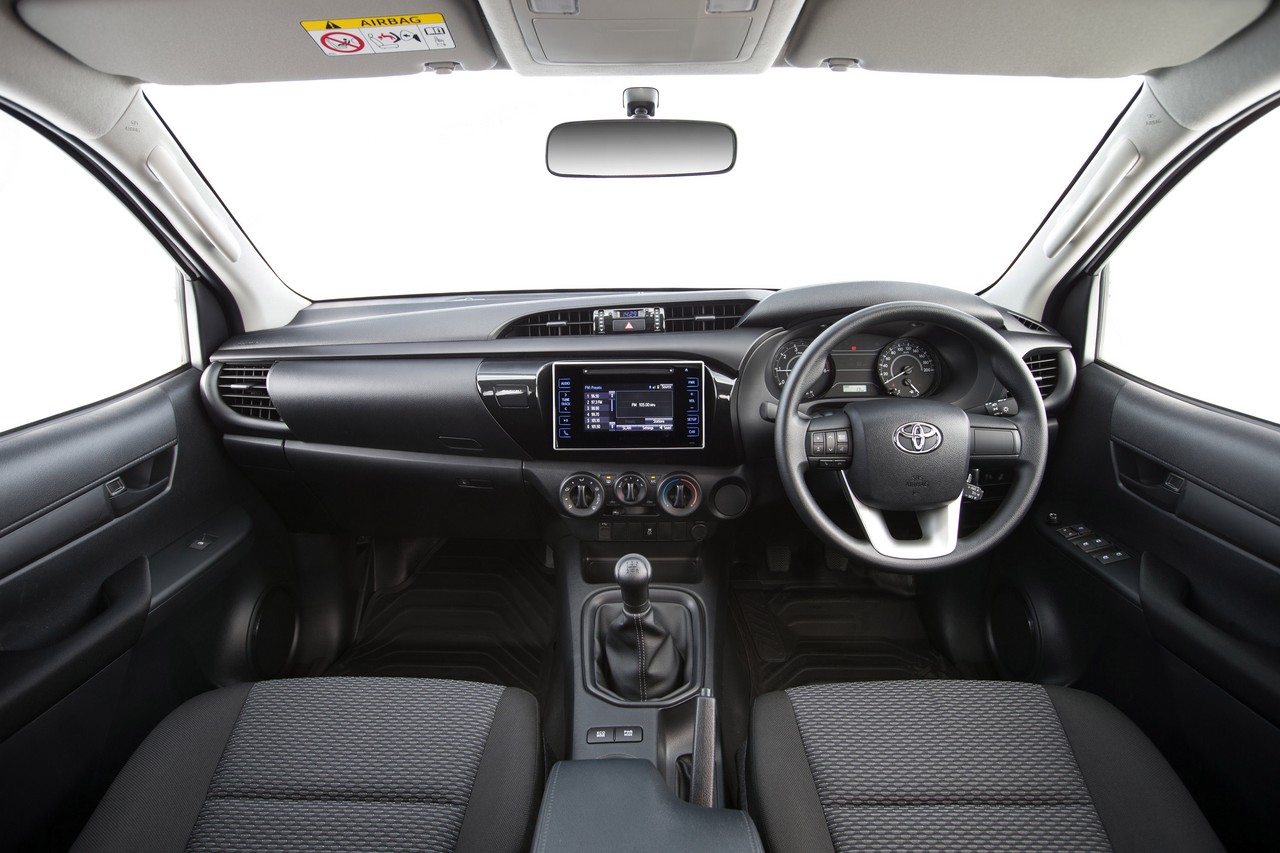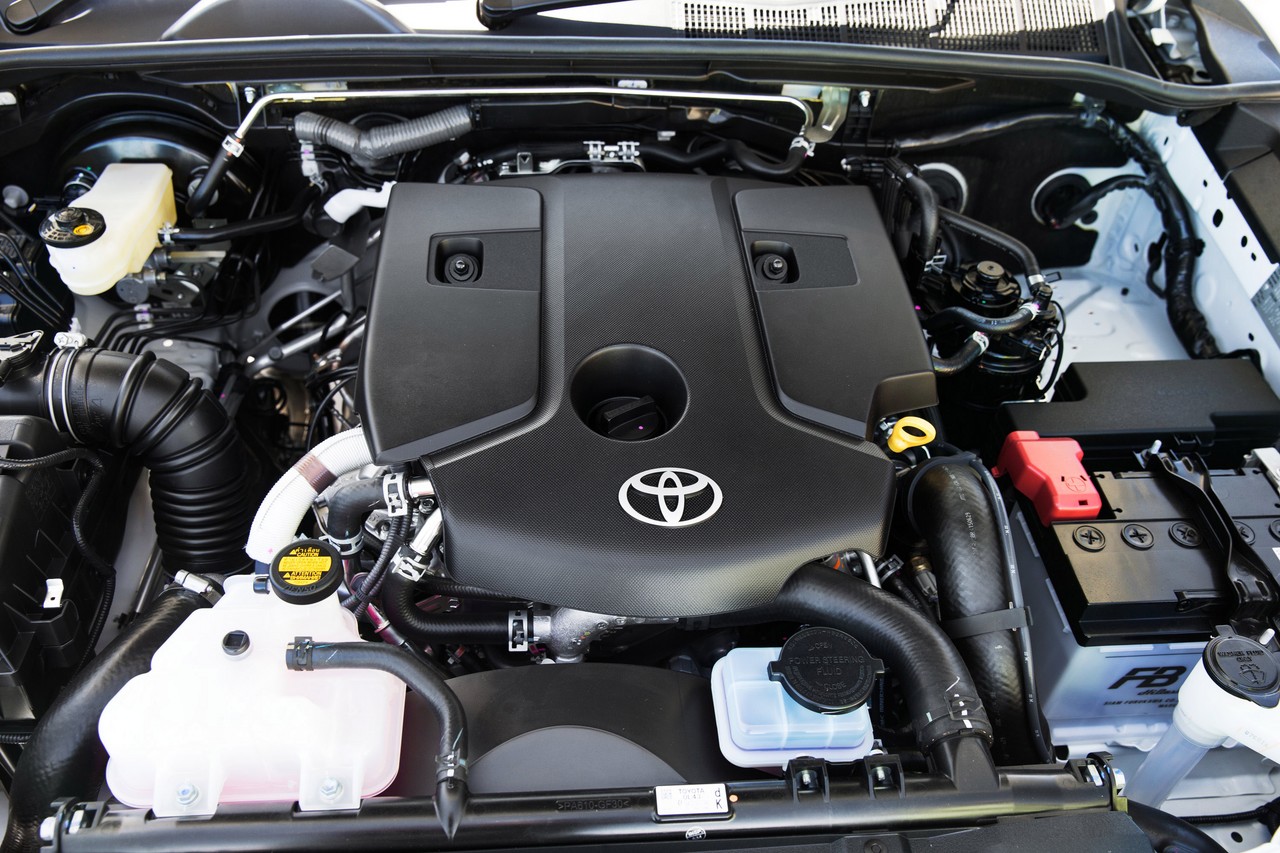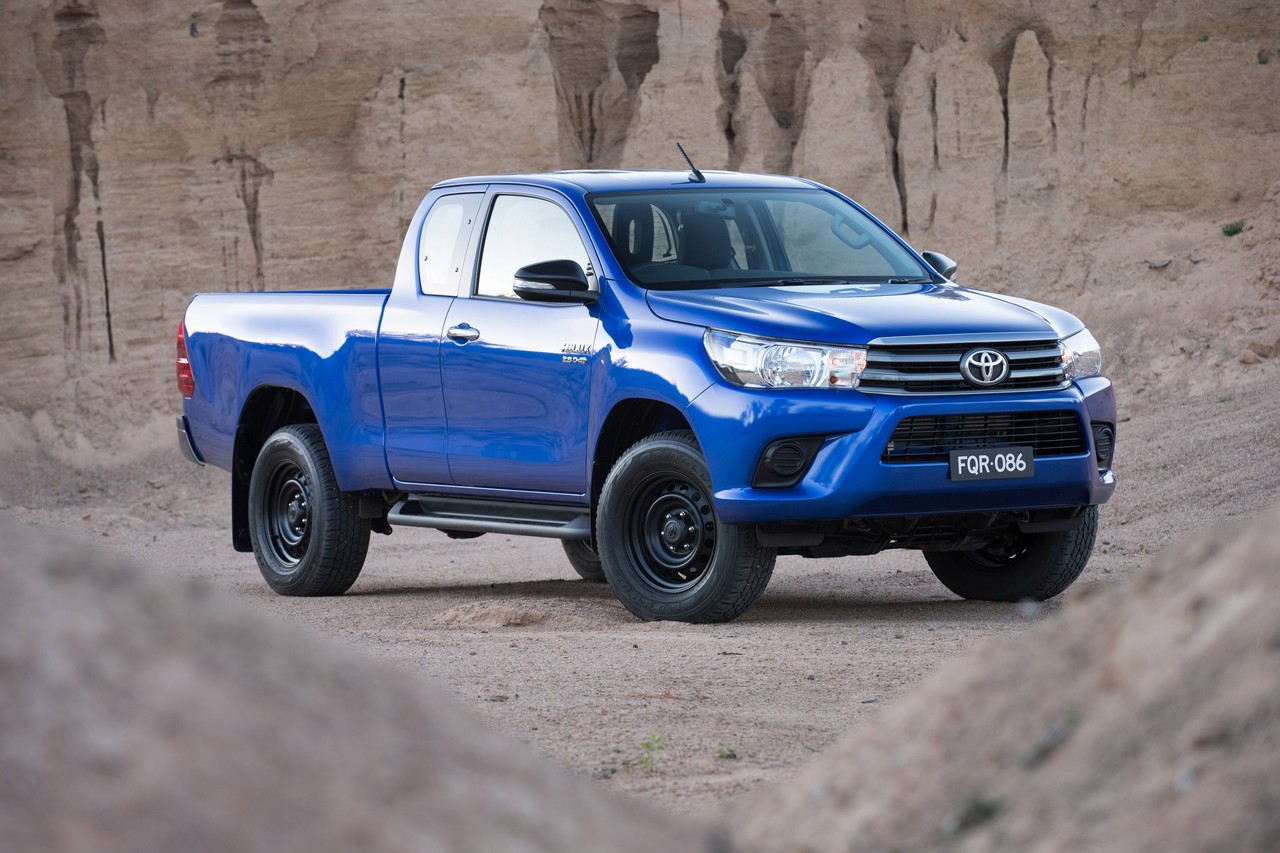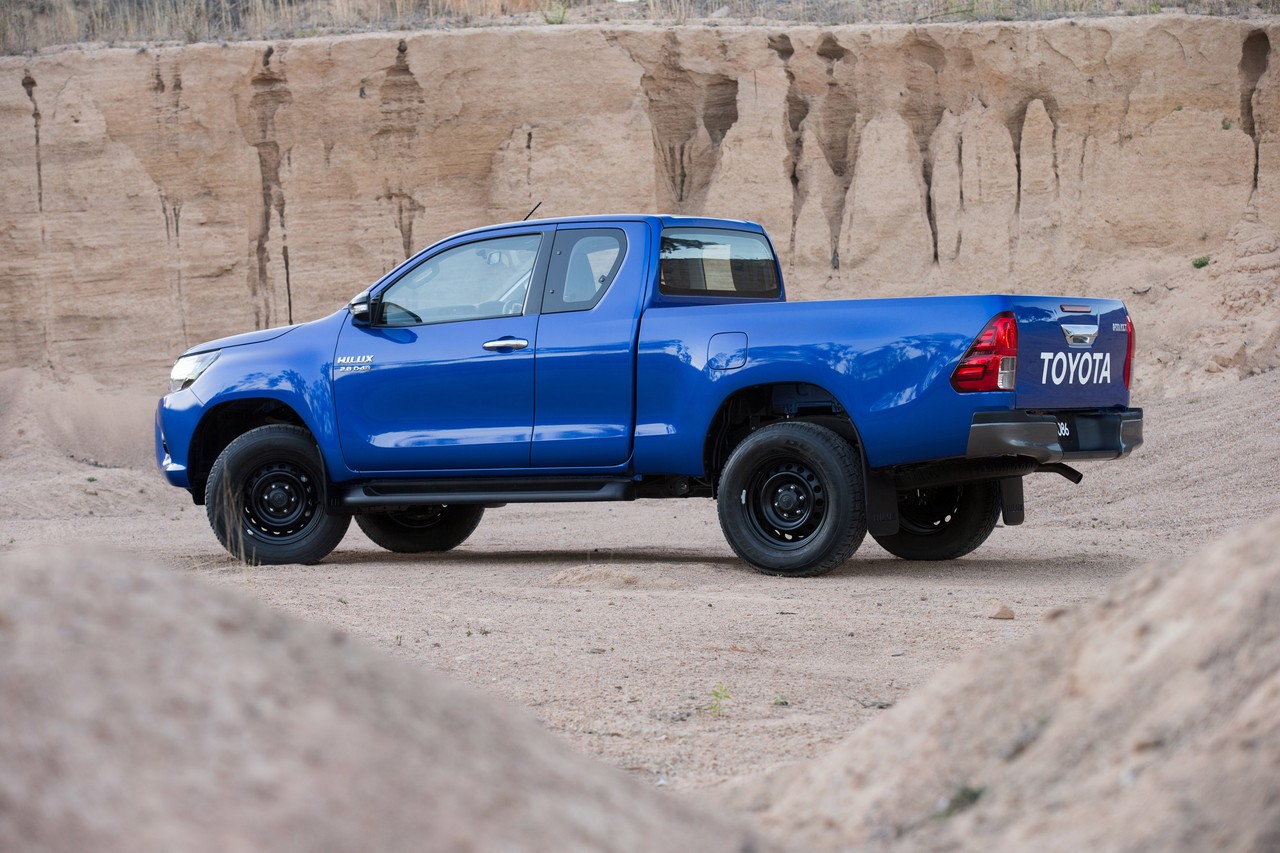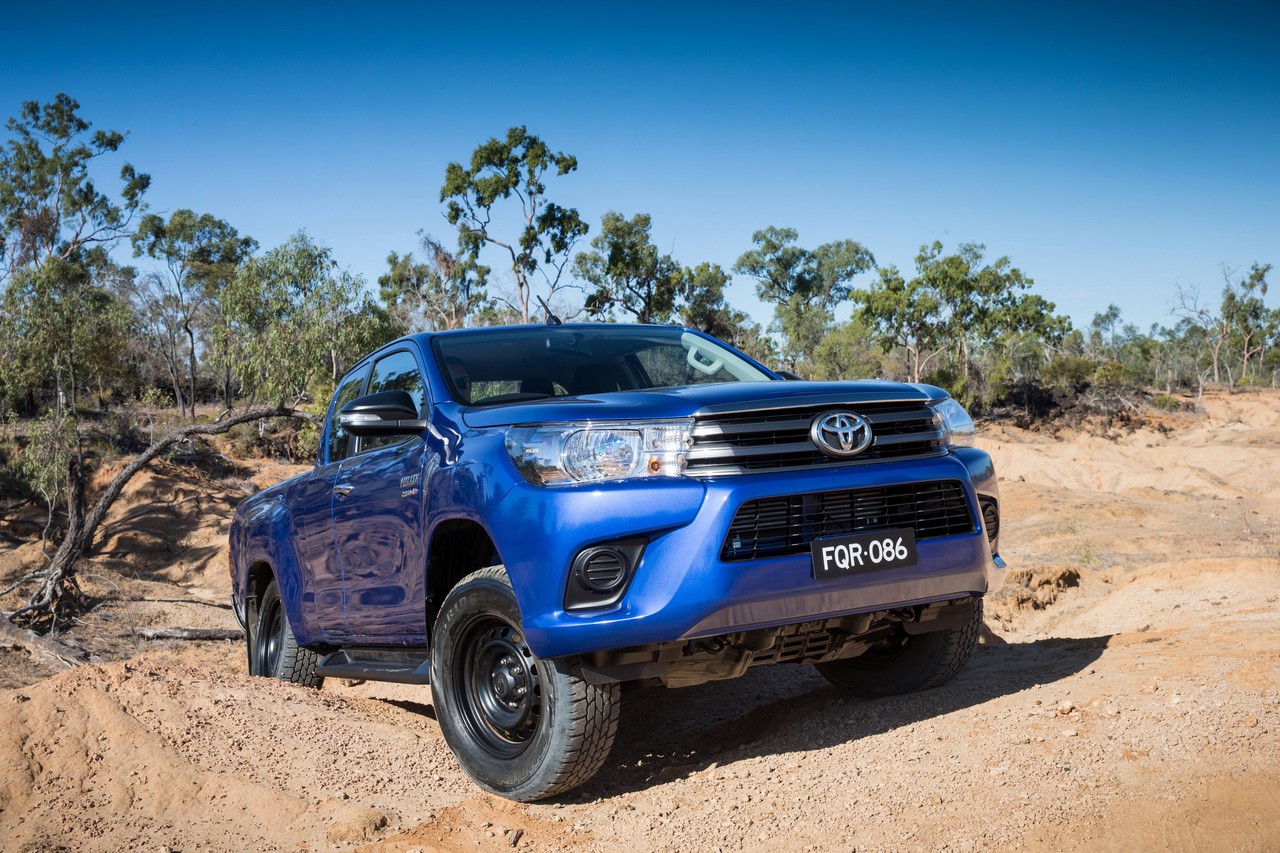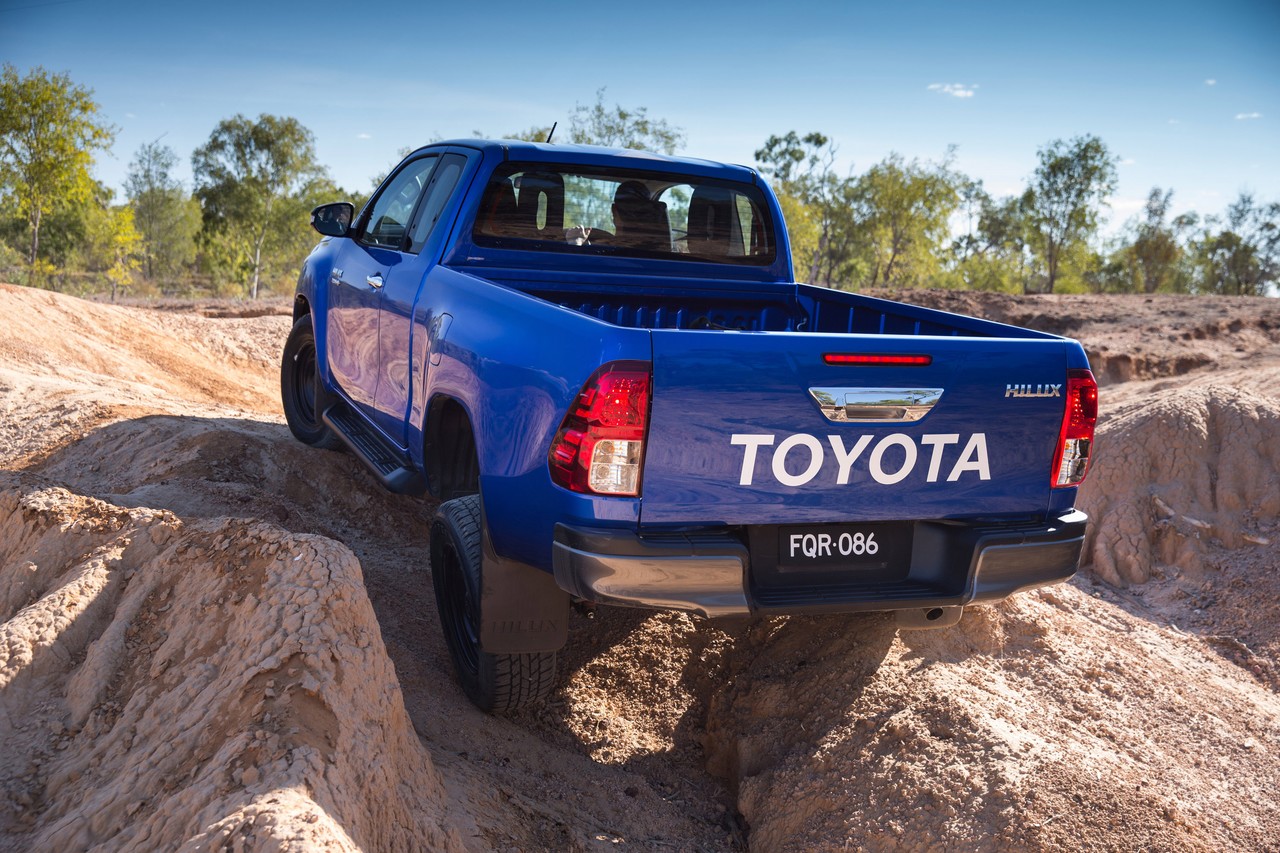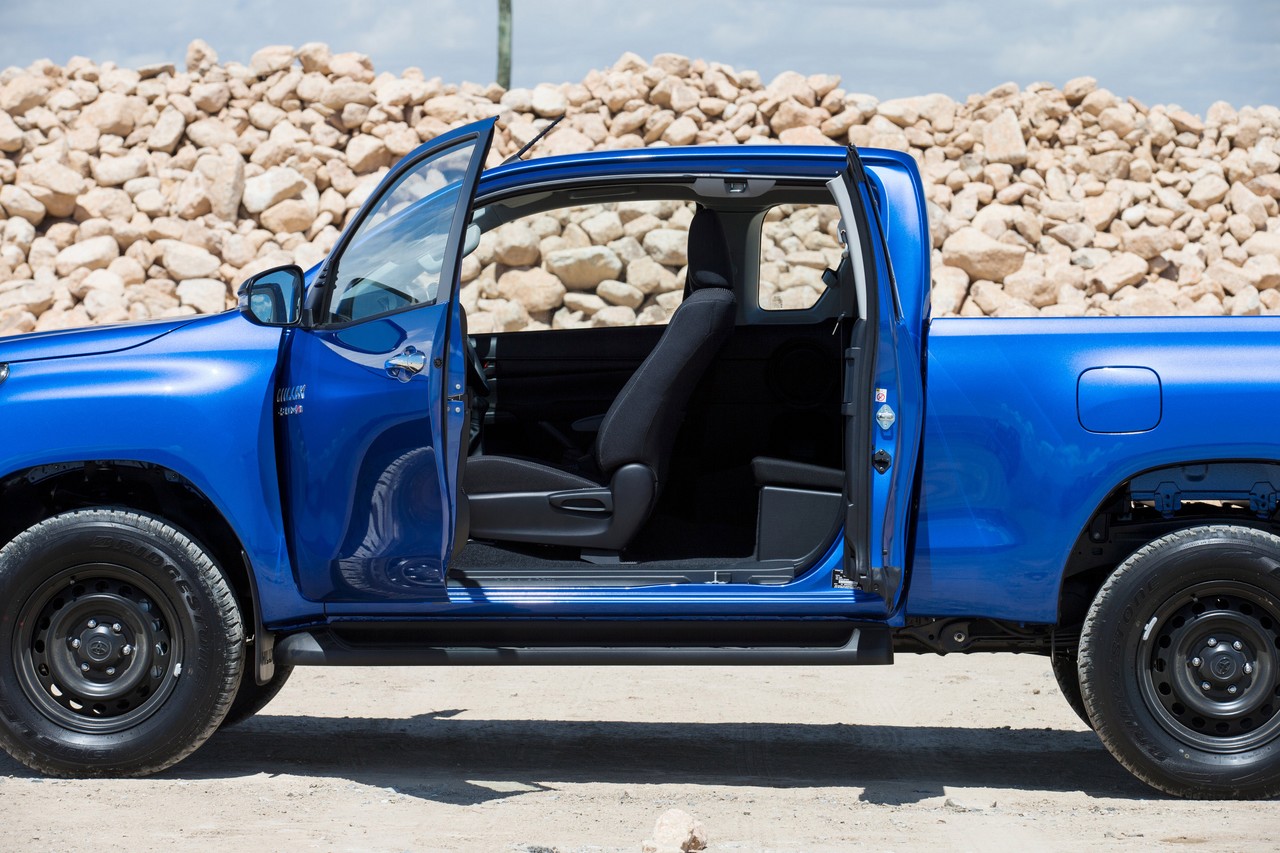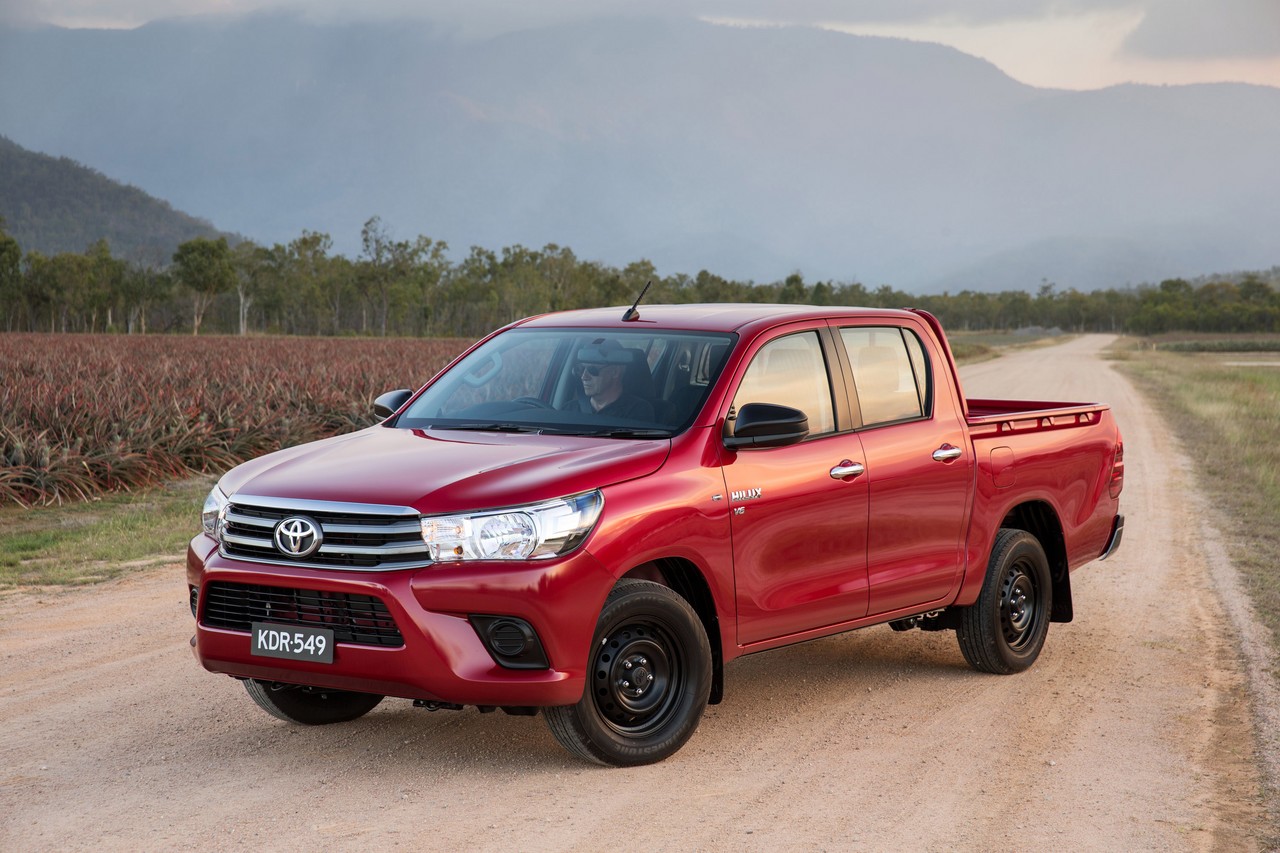
- Refined and responsive turbo-diesel engines
- Accomplished dynamics
- Well-weighted steering
- Quiet, well-insulated cabin
- For 4×4 models, off-road capability
- When unladen, suspension lacks compliance (especially with larger wheels)
- For dual cabs, upright rear seat backs and limited space
- Hard interior plastics and mismatched components
- Hilux 4×2 misses out on the torquier version of the 2.4-litre turbo-diesel engine (343 Nm vs 400 Nm)
Overview
Released in Australia in September 2015, the Toyota Mk.8 Hilux utility was available in extra cab and dual cab bodies. Manufactured in Thailand, the Toyota Mk.8 Hilux utility was available with 2.7-litre petrol, 2.4-litre turbo-diesel, 2.8-litre turbo-diesel and 4.0-litre V6 petrol engines. As per the table below, the Mk.8 Hilux utility range consisted of Workmate, SR and SR5 variants.
October 2017: range update
In October 2017, the Hilux Mk.8 Utility range was revised as the V6 petrol models were withdrawn and the range was expanded with:
- A new extra cab SR Hi-Ride 2.8TD auto variant;
- A new extra cab SR5 4×4 2.8TD auto variant;
- A new double cab Workmate Hi-Rider 2.8 TD auto variant;
- Two new double cab SR+ 4×4 2.8TD variants (i.e. manual and automatic). The SR+ models were similarly equipped to the SR variants but added satellite navigation and alloy wheels; and,
- A new double cab SR5 Hi-Rider 2.8 TD auto variant.
In April 2018, the Hilux range was expanded with the release of Rogue, Rugged and Rugged X variants.
| Body | Variant | Engine | Drive | Trans. | Peak power | Peak torque |
|---|---|---|---|---|---|---|
| Extra cab | SR | 2.8-litre turbo-diesel I4 (1GD-FTV) | 4×2 | 6sp man. | 125 kW at 3600 rpm | 343 Nm at 1200-3400 rpm |
| 4×2 Hi-Rider, 4×4 |
6sp man. | 130 kW at 3400 rpm | 420 Nm at 1600-2400 rpm | |||
| SR5 | 2.8-litre turbo-diesel I4 (1GD-FTV) | 4×4 | 6sp man. | 130 kW at 3400 rpm | 420 Nm at 1600-2400 rpm | |
| 6sp auto | 130 kW at 3400 rpm | 450 Nm at 1600-2400 rpm | ||||
| Dual cab | Work mate | 2.7-litre petrol I4 (2TR-FE) | 4×2 | 5sp man., 6sp auto |
122 kW at 5200 rpm | 245 Nm at 4000 rpm |
| 2.4-litre turbo-diesel I4 (2GD-FTV) | 4×2 | 5sp man. | 110 kW at 3400 rpm | 343 Nm at 1400-2800 rpm | ||
| 4×2 Hi-Rider | 6sp man. | 110 kW at 3400 rpm | 400 Nm at 1600-2000 rpm | |||
| 4×4 | 6sp man., 6sp auto |
110 kW at 3400 rpm | 400 Nm at 1600-2000 rpm | |||
| SR | 2.8-litre turbo-diesel I4 (1GD-FTV) | 4×2 Hi-Rider, 4×4 |
6sp man. | 130 kW at 3400 rpm | 420 Nm at 1600-2400 rpm | |
| 6sp auto | 130 kW at 3400 rpm | 450 Nm at 1600-2400 rpm | ||||
| 4.0-litre petrol V6 (1GR-FE) | 4×2, 4×4 |
6sp auto | 175 kW at 5200 rpm | 376 Nm at 3800 rpm | ||
| SR+ | 2.8-litre turbo-diesel I4 (1GD-FTV) | 4×4 | 6sp man. | 130 kW at 3400 rpm | 420 Nm at 1600-2400 rpm | |
| 6sp auto | 130 kW at 3400 rpm | 450 Nm at 1600-2400 rpm | ||||
| SR5 | 2.8-litre turbo-diesel I4 (1GD-FTV) | 4×2 HR, 4×4 |
6sp man. | 130 kW at 3400 rpm | 420 Nm at 1600-2400 rpm | |
| 6sp auto | 130 kW at 3400 rpm | 450 Nm at 1600-2400 rpm | ||||
| 4.0-litre petrol V6 (1GR-FE) | 4×4 | 6sp man. | 130 kW at 3400 rpm | 420 Nm at 1600-2400 rpm | ||
| 6sp auto | 130 kW at 3400 rpm | 450 Nm at 1600-2400 rpm | ||||
| SR5+ | 2.8-litre turbo-diesel I4 (1GD-FTV) | 4×4 | 6sp man. | 130 kW at 3400 rpm | 420 Nm at 1600-2400 rpm | |
| 6sp auto | 130 kW at 3400 rpm | 450 Nm at 1600-2400 rpm | ||||
| Rugged, Rugged X |
2.8-litre turbo-diesel I4 (1GD-FTV) | 4×4 | 6sp man. | 130 kW at 3400 rpm | 420 Nm at 1600-2400 rpm | |
| Rogue, Rugged, Rugged X |
2.8-litre turbo-diesel I4 (1GD-FTV) | 4×4 | 6sp auto | 130 kW at 3400 rpm | 450 Nm at 1600-2400 rpm |
Powertrains
The Mk.8 Hilux utility was offered with four engines, all of which complied with Euro 5 emissions standards::
- The 2.7-litre 2TR-FE four-cylinder petrol engine had a cast iron block, an aluminium alloy cylinder head, double overhead camshafts, four valves per cylinder and twin counter-rotating balance shafts. For the Mk.8 Hilux, changes included variable intake and exhaust valve timing (previously intake only), a new ‘tumble port’ intake profile to improve swirl in the combustion chamber, a 10.2:1 compression ratio (previously 10.0:1), new surface treatment on the cylinder walls, Teflon coating on the connecting rod bearings, a lower-friction cam timing chain and lighter valve gear (including roller rocker arms, retainers and valve springs). To reduce noise, insulators were also fitted to the intake and exhaust manifolds;
- The 4.0-litre 1GR-FE V6 petrol engine had an alloy block and cylinder head, double overhead camshafts (per cylinder bank, chain-driven), four valves per cylinder, variable intake valve timing (VVT-i), two-stage Acoustic Control Induction System (ACIS), electronic throttle control and a compression ratio of 10.0:1; and,
- The 2.4-litre 2GD-FTV and 2.8-litre 1GD-FTV diesel engines were members of Toyota’s ‘GD’ engine family and each featured solenoid injectors (providing injection pressure up to 2500 bar), a variable-vane turbocharger with intercooler, water-cooled exhaust gas recirculation, a diesel particulate filter and compression ratio of 15.6:1. The 2.8-litre 1GD-FTV engine, however, differed in that it had swirl control valves in the intake manifold to increase combustion efficiency and reduce exhaust emissions; the 1GD-FTV engine achieved 44 per cent thermal efficiency compared to 43 per cent for the 2GD-FTV.
The Mk.8 Hilux was available with six-speed automatic, five-speed manual and six-speed manual transmissions. The new, electronically-controlled six-speed automatic transmission adapted to driver behaviour and, in sequential mode, could blip the throttle on downshifts. For the Hilux SR5 with turbo-diesel engine, the ‘intelligent’ manual transmission (Toyota’s ‘iMT’) could provide smoother gearshifts by more accurately matching engine speed to the transmission – this capability was activated by pushing a button near the gear lever.
Body
Compared to the Toyota Mk.7 Hilux utility , the body for the Mk.8 Hilux utility:
- Made greater use of galvanised and high-tensile steel (including 590 MPa steel);
- Had side rails and cross members that were up to 30 mm thicker; and,
- Had 45 per more spot welds (388 compared to 268).
As a result of these developments, the frame for the Mk.8 Hilux achieved a 20 per cent increase in torsional rigidity compared to its predecessor. The Toyota Mk.8 Hilux utility also had a stronger tub due to a revised deck structure (with extra ribbing and reinforcements), a reinforced header board, thicker outer panels and steel-plate brackets on tailgate struts.
Developed in conjunction with the Toyota Fortuna , Toyota sought to provide the Mk.8 Hilux with ‘SUV-like’ attributes, including a more compliant ride, quieter cabins and more supportive seats. To reduce in-cabin noise, measures included:
- Improved engine bay insulation, with an outer dash silencer for petrol models and a 50 per cent larger dash silencer for diesel models;
- For Dual Cabs, additional seals between the front and rear doors; and,
- Weather strips that were extended to the rocker panel.
Dimensions
The Toyota Mk.8 Hilux utility was 5330 mm long and had a 3085 mm long wheelbase. While the Hilux 4×2 was 1800 mm wide, the Hilux Hi-Rider and 4×4 were 1855 mm wide; furthermore, height ranged from 1690 mm (4×2 single cab) to 1815 mm (Hi-Rider and 4×4 dual cab). For the dual cab 4×4, the rear tray was 1569 mm long, 1645 mm wide, had 481 mm high side panels and an 861 mm loading height (from the ground).
Suspension and underbody protection
The Toyota Mk.8 Hilux utility had double wishbone front suspension and a live rear axle with leaf springs. Compared to the Mk.7 Hilux, changes included:
- A thicker front stabiliser bar;
- Larger diameter shock absorbers;
- 1400 mm long rear leaf springs (previously 1300 mm) that were mounted 50 mm further apart; and,
- The attachment point of the rear suspension to the frame was moved 100 mm forward and 25 mm lower; and,
- The rear dampers were repositioned in front of the axle and faced forward (previously rear-facing and located behind the axle) for greater straight line stability.
Furthermore, rear wheel articulation increased to 520 mm on both sides of the vehicle (previously 433 mm on the left and 474 mm on the right).
The 4×2 Hilux was offered in Hi-Rider editions which had the ground clearance of the 4×4 models, but without the four-wheel drive hardware. Furthermore, the Hilux 4×4 and Hi-Rider models were fitted with locally-developed underbody protection which was 40 per cent thicker and covered a 30 per cent larger area than that used in the Mk.7 Hilux. According to Toyota, the Mk.8 Hilux’s underbody protection provided three times greater resistance to deformation.
4×4 and differential locks
The Mk.8 Hilux had a part-time four-wheel drive system which could be engaged by a dial next to the air conditioning temperature control. Hilux 4×4 and SR5 models were fitted with a rear differential lock which was controlled via a solenoid switch. For greater off-road protection, the locking mechanism was built into the rear differential housing.
The Hilux SR5 4×4 with automatic transmission was also fitted with Downhill Assist Control which managed vehicle speed on descents to enable the driver to focus on steering the vehicle.
Safety equipment
Standard safety equipment for the Toyota Mk.8 Hilux utility included dual front airbags, a driver’s knee airbag, front side airbags, curtain airbags, ABS, electronic brake force distribution, brake assist, electronic stability control, traction control and front seatbelts with pretensioners and load limiters.
As standard, the Mk.8 Hilux utility was also fitted with:
- A trailer sway control function which used brake control and engine output control to suppress any lateral trailer movement which may be caused by cross winds, variation in road surface or steering movements; and,
- Hill-Start Assist Control to prevent the vehicle from rolling downhill when accelerating from rest on an incline.
Safety equipment: July/August 2019 upgrade
From July 2019 for Mk.8 Hilux single cab and double cab models, and August 2019 for Mk.8 Hilux extra cab models, the following ‘Toyota Safety Sense’ technologies were fitted as standard:
- Pre-Collision Safety System (PCS) with day/night pedestrian detection and daytime cyclist detection: operating at speeds above 10 km/h, PCCS used a front-mounted monocular camera sensor and millimetre-wave radar sensor to detect vehicles and pedestrians on the road ahead, during the day or at night; cyclists could also be detected during daylight. If there was a collision risk, the driver would receive an audible warning and a ‘Brake’ message would be shown on the multi-information display. In its second stage, Pre-Collision Brake Assist prepared the braking system so that it responded faster if the brake pedal was depressed. If the driver did not react and a collision was imminent, maximum braking force would be applied automatically to reduce the severity of the collision;
- High-Speed Active Cruise Control (ACC): operating at speeds above 40 km/h, High-Speed ACC could maintain a safe distance from the vehicle ahead by braking and accelerating up to the maximum cruising speed set by the driver;
- Lane Departure Alert (LDA) with steering assistance: used the windscreen-mounted camera to monitor the vehicle’s position relative to lane markings on the road surface. If the vehicle was about to depart from its lane without the turn indicator having been applied, an audible tone would alert the driver and a warning would appears in the multi-information display. If the Hilux continued to move outside the lane, steering force would be applied to assist the driver in returning the vehicle to its lane; and,
- Road Sign Assist (RSA): the windscreen-mounted camera could recognise certain speed limit signs so that the speed limit was displayed on the multi-information display (MID) in the instrument cluster.
Coinciding with this safety upgrade, Hilux Workmate variants were fitted with an enhanced instrument cluster which included a 4.2-inch Multi-Information Display (as per other variants).
Brakes
The Hilux 4×2 was fitted with 296 mm ventilated front brake discs with floating calipers and 254 mm rear drum brakes. The Hilux 4×4 and Hi-Rider, however, had 319 mm ventilated front brake discs with opposed-piston calipers and 295 mm self-adjusting rear drum brakes with leading and trailing shoes.
ANCAP crash testing
In ANCAP crash testing , the Toyota Hilux 4×4 dual cab utility received a five adult occupant protection rating with a score of 34.45 out of 37. In the frontal offset test, protection of the driver’s chest, thighs and feet were rated as good, though protection of the head and lower left leg were rated as acceptable (i.e. a slight risk of serious injury); protection of the driver’s lower right leg was rated as marginal.
Euro NCAP testing
In Euro NCAP testing , the standard 2016 Toyota Hilux dual cab utility received a three star safety rating which included an 85 per cent adult occupant protection rating and an 82 per cent child occupant protection rating. In the frontal offset test, protection of the driver’s neck, thighs and feet were rated as good, though head, chest and lower leg protection were rated as adequate (i.e. a slight risk of serious injury). Maximum points, however, were received in the side impact and pole tests.
In Europe, the Toyota Hilux was available with ‘Toyota Safety Sense’ which included autonomous emergency braking; Hilux vehicles with Toyota Safety Sense received a five star safety rating due to higher scores in the pedestrian and ‘safety assist’ categories.
Wheels and tyres
The Mk.8 Hilux utility was offered with three wheel and tyre packages –
- For the single cab Workmate 4×4 and SR 4×4: 17-inch steel wheels with 225/70 R17C all-terrain tyres;
- For the SR Hi-Rider, extra cab Workmate 4×4 and SR 4×4, and extra/dual cab SR: 17-inch steel wheels with 265/65 R17 all-terrain tyres; and,
- For the Hilux SR5: 18-inch alloy wheels with 265/60 R18 highway tyres.
Features: Hilux Workmate
Standard features for the Hilux Workmate included two speaker sound system with CD player, auxiliary inputs (3.5 mm/USB) and a 6.1-inch touch screen, Bluetooth connectivity with audio streaming and voice recognition, air conditioning, black seat fabrics, cruise control, a reversing camera, central locking, power windows and mirrors, a tilt adjustable steering wheel, a 12 volt power socket and vinyl floor covering.
For all Hilux utilities other than the 4×2 single cabs, the steering wheel had telescopic adjustment (in addition to tilt adjustment). Furthermore, all Hilux Hi-Rider and 4×4 models were fitted with an under-bonnet fuse box for safe connection to the vehicle’s power supply when multiple accessories were fitted.
Features: Hilux SR and SR5
Compared to the Workmate, the Hilux SR was further equipped with premium fabric seat trim, an air conditioned cooler/heater box, a height adjustable driver’s seat, carpeted floors and monochrome multi-information display. Visually, the Hilux SR could be identified by its black painted B-pillar.
The Hilux SR and SR5 Extra cab were fitted with a four speaker sound system, while the SR and SR5 double cab added:
- A six speaker sound system, seven-inch touch screen;
- ‘Toyota Link’ which could provide access to Pandora internet radio, find destinations, weather information and other assistance; and,
- A 60/40 split and folding rear seat base with central armrest.
The Hilux SR5 was distinguished by its digital radio (DAB) tuner, satellite navigation system, climate control air conditioning, LED headlights, LED daytime running lights, fog lamps, premium steering wheel and gearshift knob, power folding door mirrors, proximity key (i.e. keyless entry), push-button start, a second 12 volt power socket, privacy glass, 4.2-inch colour multi-information display and alarm system. The Hilux SR5 could be identified by its chrome radiator grille, chrome exterior door mirrors and handles, stainless steel sports bar and chrome rear step.
The Hilux SR5 double cab was also fitted with a 220 volt accessory socket. Toyota’s Hilux SR5+ was powered by the 2.8-litre turbo-diesel engine and fitted with the optional power adjustable driver’s seat and leather-accented trim.
October 2017: features update
As noted above, the Toyota Mk.8 Hilux utility range was updated in October 2017. At this time, the following standard equipment changes were also made –
- Hilux SR variants were fitted with PVC floor covering (previously carpet), downhill assist control and black door handles;
- Hilux extra cab SR and SR5 utilities were fitted with a tailgate lock;
- The newly introduced SR+ variants were similarly equipped to the SR variants but added satellite navigation and alloy wheels (and had a retail price of $2000 more than the SR);
- Hilux SR5 variants were equipped with LED fog lamps; and,
- Hilux double cab SR5 4×4 and 4×2 Hi-Rider variants were fitted with rear air vents.
Toyota HiLux Rugged, Rugged X and Rogue
In April 2018, the Toyota Mk.8 Hilux 4×4 double cab range was expanded with the introduction of Rugged, Rugged X and Rogue variants. While the HiLux Rugged and HiLux Rugged X were targeted at ‘off-road enthusiasts’, the HiLux Rogue was described by Toyota as ‘premium and sporty’.
While the HiLux Rugged was based on the HiLux SR, the HiLux Rugged X and Rogue were based on the HiLux SR5. Both the HiLux Rugged and Rugged X were fitted with a snorkel, side rock rails, recovery points (front and rear), and a heavy-duty steel rear bar with integrated step, a tub liner with tailgate protection, an integrated tow bar and a seven-pin flat trailer wiring harness. The HiLux Rugged, however, was also fitted with a steel bull bar, while the HiLux Rugged X instead had a winch-compatible steel front bar with an integrated alloy bash plate, a centrally mounted 66 cm LED light bar with a maximum output of 120 watts and 20 watt ‘spread beam’ driving lights. In the rear tub, the HiLux Rugged, Rugged X and Rogue all had a black steel sports bar that could support a vertical load of 75 kg and, with multiple tie-down points, could secure up to 200 kg on the floor of the tub.
Inside, the HiLux Rugged featured a digital radio tuner (DAB+), satellite navigation and all-weather floor mats (front and rear). The HiLux Rugged X and Rogue also featured black perforated leather-accented seats, a unique instrument cluster with white illumination and orange needles, metallic black ornamentation and a black headlining.
Visually, the HiLux Rugged could be identified by its 17-inch ‘Tough’ alloy wheels with 265/65 R17 tyres, re-designed front grille, black body side mouldings, a black tailgate handle (with integrated camera), dark grey ‘HiLux’ badges and ‘Rugged’ decals. The HiLux Rugged X also had black wheel arch mouldings, gloss black door mirror caps and door handles, and a matt black tail lamp surround.
Solely available with an automatic transmission, the Toyota HiLux Rogue was differentiated from the HiLux SR5 by its ‘Marine-grade’ carpet tub liner, integrated tow bar and seven-pin flat trailer wiring harness. Visually, the HiLux Rogue could be identified by its 18-inch ‘Rogue’ alloy wheels with 265/60 R18 tyres, more vertical front end with a unique trapezoidal grille and honeycomb insert, outboard LED fog lamps, gloss black door mirror caps and door handles, black tailgate handle with integrated camera, grey-painted rear bumper with a larger step, body-coloured hard tonneau cover, dark grey ‘HiLux’ badges and ‘Rogue’ decals.
All major new components for the HiLux Rugged and Rugged X were sourced from Australian suppliers and fitted at a Patrick Autocare facility in Port Melbourne. Australian suppliers included Frontline Australasia (for the front and rear bars, bull bar and sports bar), Brown & Watson International (for the LED light bar and driving lights), ARB (for the rock rails and recovery points) and ERG Group (for HiLux Rogue’s hard tonneau cover).
August 2018 update
From August 2018, the Toyota HiLux SR and SR5 extra cab and double cab models were fitted with a new front-end design – styled by Toyota’s Australian design team – that was previously introduced for the Toyota HiLux Rogue. The front-end design had a ‘stronger, more vertical profile with its large trapezoidal grille, honeycomb insert and outboard fog lamps’. Furthermore, the grille and fog lamp bezels had chrome finishes. While the HiLux SR models gained halogen fog lights, the HiLux SR5 models featured LED headlights and LED fog lamps.
From August 2018, the 2.4- and 2.8-litre diesel-fuelled models gained a ‘Diesel Particulate Filter’ switch which could be used to manually initiate regeneration of the diesel particulate filter (DPF) after a warning signal was issued to the driver. Specifically, regeneration injected extra diesel fuel post-combustion to raise exhaust gas temperatures so that particulate matter on the filter would be burnt off. While DPF regeneration was normally initiated by the engine control unit (ECU), regeneration would only initiate if the vehicle were driven at high speeds for long periods.
Paint finishes
The Toyota Mk.8 Hilux single cab was available in white, silver, graphite, black and blue paint finishes. Beyond this, the Hilux extra cab and dual cab were also available in red, while Crystal Pearl was reserved for the Hilux SR5 dual cab.
Brochure
Related links
- Toyota Pressroom: Toyota HiLux Rugged, Rugged X and Rogue (April 2018)
- Toyota Pressroom: Toyota Hilux Press Kit (September 2015)
- Toyota Pressroom: New Hilux – Tougher and More Refined (September 2015)
- Toyota Australia: Toyota Hilux
- Wikipedia.org: Toyota Mk.8 Hilux
- Behind the Wheel: 2016 Toyota Hilux SR5 Review

